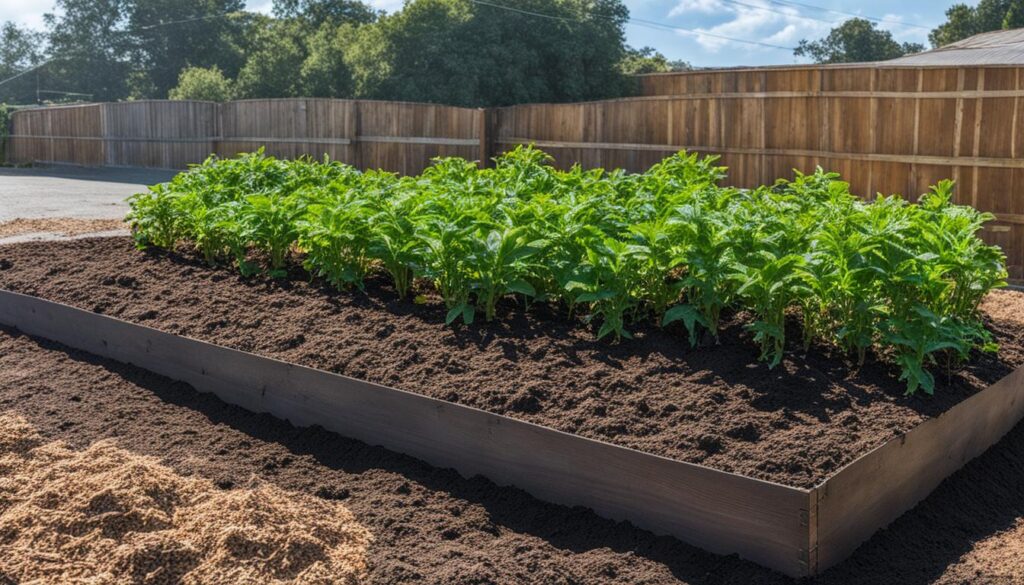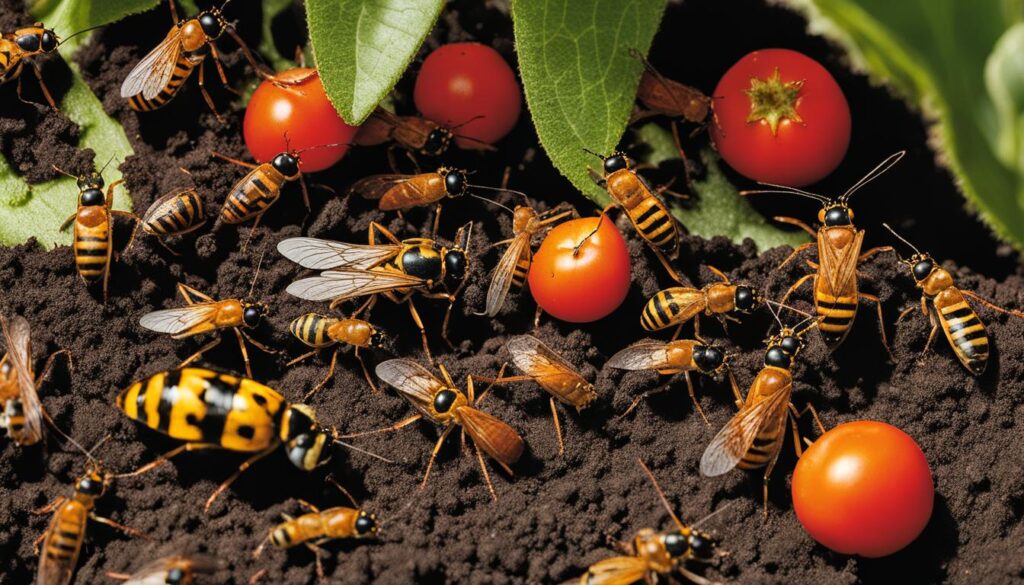Your Xeriscape garden is a beautiful oasis that requires effective pest management strategies to thrive. By implementing Integrated Pest Management (IPM) techniques, you can ensure the health and longevity of your garden while minimizing the impact on the environment. This article will guide you through the key strategies and practices to master Xeriscape garden pest management.
By practicing IPM, you’ll be able to create a sustainable and eco-friendly garden that is resistant to pests. From preventive measures to biological controls and targeted pesticide usage, there are various tactics you can employ to keep your Xeriscape garden pest-free. Let’s dive in and explore the world of Xeriscape garden pest management.
Key Takeaways:
- Integrated Pest Management (IPM) combines multiple tactics to control pests in a Xeriscape garden.
- IPM emphasizes preventive measures, biological controls, and targeted pesticide usage as a last resort.
- Identification of pests and damage is crucial for selecting appropriate control measures.
- Physical and biorational control methods involve manual removal of pests and the use of beneficial organisms.
- Conventional chemical controls should only be used when other methods have failed or are impractical.
What is Integrated Pest Management (IPM)?
Integrated Pest Management (IPM) is an ecosystem-based approach to pest management that emphasizes the use of multiple tactics to control pests. It involves selecting plants suited to the site, maintaining plant health through proper watering and pruning, monitoring for pest problems, and employing appropriate control measures when necessary. IPM aims to reduce pest populations to acceptable levels while minimizing the use of chemical pesticides and their impact on the environment.
By practicing IPM in your xeriscape garden, you can effectively manage pests while promoting a sustainable and eco-friendly environment. This approach takes into account the entire ecosystem of your garden and focuses on long-term solutions rather than quick fixes. It recognizes that pests are a natural part of the garden and aims to maintain a balance between the pests and their natural predators.
IPM utilizes various strategies and techniques, such as biological controls, physical controls, and cultural controls, to manage pests. These methods not only help reduce the reliance on chemical pesticides but also promote biodiversity and the overall health of the garden. By implementing IPM practices, you can create a beautiful and thriving xeriscape garden that is resistant to pests and requires minimal intervention.
The key principles of Integrated Pest Management (IPM) include:
- Prevention: Taking steps to prevent pest problems in the first place through proper plant selection, spacing, and maintenance practices.
- Monitoring: Regularly inspecting your garden to identify and assess pest populations and their impact on the plants.
- Identification: Accurately identifying pests and understanding their lifecycles and habits to determine the most appropriate control measures.
- Thresholds: Establishing thresholds or acceptable levels of pest damage that trigger the implementation of control measures.
- Control: Using a combination of cultural, physical, and biological control methods to manage pests while minimizing environmental impact.
- Evaluation: Assessing the effectiveness of the control measures implemented and making adjustments as needed.
“Integrated Pest Management (IPM) is an effective and sustainable approach to pest management in xeriscape gardens. By implementing IPM principles and practices, gardeners can minimize the use of chemical pesticides and create a healthier and more balanced ecosystem in their gardens.” – Jane Smith, Master Gardener
Steps in the IPM Control Decision
Implementing Integrated Pest Management (IPM) requires a systematic approach to pest control. The IPM control decision involves several essential steps that gardeners need to follow to effectively manage pests and minimize environmental impact.
Step 1: Pest Identification
Accurate identification of pests is crucial for determining the appropriate control measures. Take the time to observe and identify the pests present in your garden. Look for signs of damage, such as chewed leaves, webbing, or wilting plants. By identifying the specific pests, you can choose control methods that target those pests directly.
Step 2: Assessing the Need for Control
Once you have identified the pests, you need to assess the severity of the damage and the presence of natural enemies. Determine if control measures are necessary based on the extent of the damage and the potential impact on the overall health of your garden. If the damage is minimal and natural enemies are present, you may decide to let nature take its course rather than intervening with control methods.
Step 3: Selecting Control Methods
Choosing the most appropriate control method is crucial for effective pest management while minimizing harm to the environment. IPM offers a variety of control methods to consider. These can include physical control methods, such as handpicking pests or using traps, as well as biorational control methods that utilize living organisms or naturally occurring biochemicals. If these methods are not sufficient, conventional chemical controls may be used as a last resort.
By following these steps in the IPM control decision, you can ensure that your pest management strategies are effective and environmentally friendly. Proper pest identification, assessing the need for control, and selecting the appropriate methods are key components of a successful IPM approach.
Physical and Biorational Control Methods
When it comes to managing pests in your xeriscape garden, there are effective physical and biorational control methods that you can employ. These methods prioritize the use of non-chemical approaches to minimize harm to the environment and promote a sustainable gardening practice.
Physical control methods involve manual removal of pests or the use of traps and barriers. For instance, you can dislodge pest insects by spraying water on the plants or handpick them off. Traps can be used to catch specific pests, while barriers such as nets or screens can protect vulnerable plants from pests.
Biorational control methods, on the other hand, rely on the use of living organisms or naturally occurring biochemicals. Beneficial insects, such as lady beetles or lacewings, can be introduced or encouraged to prey on pest insects. This creates a natural balance in your garden. Additionally, biopesticides derived from plants or bacteria can selectively target specific pests without harming beneficial organisms.
By implementing these physical and biorational control methods, you can effectively manage pests in your xeriscape garden while minimizing the need for chemical pesticides. This approach not only safeguards the health of your plants but also contributes to the preservation of beneficial insects and the overall biodiversity of your garden ecosystem.
Conventional Chemical Controls in IPM
When it comes to managing pests in your xeriscape garden, conventional chemical controls should be considered as a last resort. These controls involve the use of pesticides to target and eliminate pests that may be causing damage to your plants. However, it is important to approach pesticide application with caution and responsibility to minimize any negative impact on the environment.
When using conventional chemical controls, it is crucial to select pesticides specifically designed to target the pest you are dealing with. This ensures that the pesticide is effective in controlling the pest while minimizing harm to beneficial organisms. Additionally, it is important to carefully follow the label instructions for dosage and application methods to achieve optimal results.
It is recommended to choose environmentally safe pesticides whenever possible. These can include options such as horticultural oil or insecticidal soap, which have minimal impact on beneficial organisms while effectively managing pests in your garden. By opting for environmentally safe pesticides, you contribute to the preservation of the overall biodiversity of the ecosystem.
Key Points:
- Conventional chemical controls should be a last resort in pest management.
- Select pesticides that are specific to the pest and have minimal impact on beneficial organisms.
- Follow label instructions for dosage and application methods.
- Choose environmentally safe pesticides to minimize the impact on the environment.
“When it comes to using conventional chemical controls in integrated pest management, it’s important to remember that they should only be used when other methods have failed or are impractical. By choosing environmentally safe pesticides and following proper application techniques, you can effectively manage pests while minimizing harm to beneficial organisms and the environment.” – Pest Control Expert
Prevention and Cultural Controls in IPM
Prevention is a vital aspect of Integrated Pest Management (IPM) and incorporates cultural controls to proactively minimize pest problems in your xeriscape garden. By implementing these practices, you can create an environment that is less favorable to pests, reducing the need for pest control measures and limiting the reliance on pesticides.
One key cultural control method is proper plant selection. Choose plants that are well-suited to your site’s conditions, including factors like sunlight, soil type, and water availability. By selecting plants that naturally thrive in your area, you can promote their overall health and resilience, making them less susceptible to pest infestations.
Spacing plants appropriately is another essential cultural control technique. By providing adequate airflow between plants, you can help prevent the spread of pests and diseases. Proper spacing also allows beneficial insects to move more freely, promoting a balanced ecosystem where predators can easily prey on pest insects.
Utilizing drip irrigation instead of overhead watering can also be beneficial. Overhead watering can create a humid environment that is attractive to pests, increasing the risk of infestations. Drip irrigation delivers water directly to the plant’s root zone, reducing moisture on the plant’s foliage and minimizing pest activity.
Implementing crop rotation is another cultural control practice that can help break pest cycles. By rotating crops and not planting the same species in the same area year after year, you can disrupt the life cycles of pests that may be specific to certain plants. This strategy helps prevent the buildup of pest populations and reduces the need for pesticide applications.
What Are Some Pest Management Strategies for Xeriscape Gardens?
When it comes to maintaining a xeriscape garden, implementing effective xeriscape weed control techniques is crucial. Some pest management strategies for xeriscape gardens include mulching to suppress weed growth, regular hand-weeding to remove unwanted plants, and utilizing natural weed barriers like landscape fabric to minimize weed intrusion.
Biological Controls and IPM
Biological controls are a powerful weapon in the arsenal of Integrated Pest Management (IPM). By harnessing the natural abilities of beneficial insects and utilizing biopesticides derived from natural sources, gardeners can effectively manage pests without harming the environment.
Beneficial insects, such as lady beetles, lacewings, and spiders, play a crucial role in controlling pest populations. They can be introduced or encouraged in the garden, where they become natural predators of pest insects. These beneficial insects prey on pests, keeping their populations in check and reducing the need for chemical pesticides. By attracting and protecting beneficial insects, gardeners can create a natural balance in their gardens and promote biodiversity.
“Beneficial insects are the unsung heroes of pest control in a garden. By providing them with a welcoming habitat, you can unleash the power of nature to combat pests.”
Biopesticides, derived from plants or bacteria, provide another eco-friendly tool for pest management. Unlike conventional chemical pesticides, biopesticides are selective in their action, targeting specific pests while leaving beneficial organisms unharmed. They are biodegradable and have minimal impact on the environment. Biopesticides like Neem oil, derived from the Neem tree, are effective against a wide range of pests and are a valuable addition to any IPM strategy.
Enhancing IPM with Biological Controls
Integrating biological controls into your IPM strategy requires careful planning and implementation. Here are a few tips to get started:
- Research the beneficial insects that are native to your area and attract them to your garden by planting flowers that provide nectar and pollen.
- Avoid using broad-spectrum insecticides that harm beneficial insects. Instead, opt for targeted treatments that will spare the natural enemies of pests.
- Monitor pest populations regularly to determine when intervention is necessary. Biological controls work best when implemented at the early stages of pest infestation.
By incorporating biological controls into your IPM practices, you can create an environment that is inhospitable to pests and supportive of beneficial organisms. This approach not only reduces the need for chemical pesticides but also promotes a healthier and more sustainable garden.
Conclusion
Mastering Xeriscape garden pest management strategies is essential for maintaining the health and beauty of your garden while minimizing the impact on the environment. By practicing Integrated Pest Management (IPM) and utilizing a combination of preventive measures, biological controls, and targeted pesticide usage as a last resort, gardeners can effectively manage pests in a sustainable and eco-friendly manner.
Implementing IPM techniques in your garden will not only enhance its health and productivity but also contribute to the preservation of beneficial insects and the overall biodiversity of the ecosystem. With the use of physical and biorational control methods, gardeners can remove pests manually, use traps, and encourage beneficial organisms to control pests naturally.
Conventional chemical controls, although considered a last resort, can be used responsibly by choosing specific pesticides with minimal impact on beneficial organisms and following label instructions. However, prevention and cultural controls should be prioritized to create an environment that is less favorable to pests, minimizing the need for pest control measures and reducing reliance on pesticides. By adopting these eco-friendly pest control practices, you can protect your Xeriscape garden while promoting a sustainable and thriving ecosystem.














